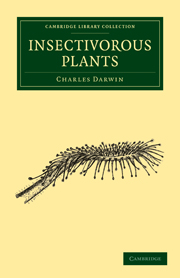Book contents
- Frontmatter
- Contents
- CHAPTER I DROSERA ROTUNDIFOLIA, OR THE COMMON SUN-DEW
- CHAPTER II THE MOVEMENTS OF THE TENTACLES FROM THE CONTACT OF SOLID BODIES
- CHAPTER III AGGREGATION OF THE PROTOPLASM WITHIN THE CELLS OF THE TENTACLES
- CHAPTER IV THE EFFECTS OF HEAT ON THE LEAVES
- CHAPTER V THE EFFECTS OF NON-NITROGENOUS AND NITROGENOUS ORGANIC FLUIDS ON THE LEAVES
- CHAPTER VI THE DIGESTIVE POWER OF THE SECRETION OF DEOSERA
- CHAPTER VII THE EFFECTS OF SALTS OF AMMONIA
- CHAPTER VIII THE EFFECTS OF VARIOUS OTHER SALTS, AND ACIDS, ON THE LEAVES
- CHAPTER IX THE EFFECTS OF CERTAIN ALKALOID POISONS, OTHER SUBSTANCES AND VAPOURS
- CHAPTER X ON THE SENSITIVENESS OF THE LEAVES, AND ON THE LINES OF TRANSMISSION OF THE MOTOR IMPULSE
- CHAPTER XI RECAPITULATION OF THE CHIEF OBSERVATIONS ON DROSERA ROTUNDIFOLIA
- CHAPTER XII ON THE STRUCTURE AND MOVEMENTS OF SOME OTHER SPECIES OF DROSERA
- CHAPTER XIII DIONÆA MUSCIPULA
- CHAPTER XIV ALDROVANDA VESICULOSA
- CHAPTER XV DROSOPHYLLUM — RORIDULA — BYBLIS — GLANDULAR HAIRS OF OTHER PLANTS — CONCLUDING REMARKS ON THE DROSERACEÆ
- CHAPTER XVI PINGUICULA
- CHAPTER XVII UTRICULARIA
- CHAPTER XVIII UTRICULARIA (continued)
- ERRATA
- INDEX
CHAPTER VI - THE DIGESTIVE POWER OF THE SECRETION OF DEOSERA
Published online by Cambridge University Press: 29 August 2010
- Frontmatter
- Contents
- CHAPTER I DROSERA ROTUNDIFOLIA, OR THE COMMON SUN-DEW
- CHAPTER II THE MOVEMENTS OF THE TENTACLES FROM THE CONTACT OF SOLID BODIES
- CHAPTER III AGGREGATION OF THE PROTOPLASM WITHIN THE CELLS OF THE TENTACLES
- CHAPTER IV THE EFFECTS OF HEAT ON THE LEAVES
- CHAPTER V THE EFFECTS OF NON-NITROGENOUS AND NITROGENOUS ORGANIC FLUIDS ON THE LEAVES
- CHAPTER VI THE DIGESTIVE POWER OF THE SECRETION OF DEOSERA
- CHAPTER VII THE EFFECTS OF SALTS OF AMMONIA
- CHAPTER VIII THE EFFECTS OF VARIOUS OTHER SALTS, AND ACIDS, ON THE LEAVES
- CHAPTER IX THE EFFECTS OF CERTAIN ALKALOID POISONS, OTHER SUBSTANCES AND VAPOURS
- CHAPTER X ON THE SENSITIVENESS OF THE LEAVES, AND ON THE LINES OF TRANSMISSION OF THE MOTOR IMPULSE
- CHAPTER XI RECAPITULATION OF THE CHIEF OBSERVATIONS ON DROSERA ROTUNDIFOLIA
- CHAPTER XII ON THE STRUCTURE AND MOVEMENTS OF SOME OTHER SPECIES OF DROSERA
- CHAPTER XIII DIONÆA MUSCIPULA
- CHAPTER XIV ALDROVANDA VESICULOSA
- CHAPTER XV DROSOPHYLLUM — RORIDULA — BYBLIS — GLANDULAR HAIRS OF OTHER PLANTS — CONCLUDING REMARKS ON THE DROSERACEÆ
- CHAPTER XVI PINGUICULA
- CHAPTER XVII UTRICULARIA
- CHAPTER XVIII UTRICULARIA (continued)
- ERRATA
- INDEX
Summary
As we have seen that nitrogenous fluids act very differently on the leaves of Drosera from non-nitrogenous fluids, and as the leaves remain clasped for a much longer time over various organic bodies than over inorganic bodies, such as bits of glass, cinder, wood, &c., it becomes an interesting inquiry, whether they can only absorb matter already in solution, or render it soluble,—that is, have the power of digestion. We shall immediately see that they certainly have this power, and that they act on albuminous compounds in exactly the same manner as does the gastric juice of mammals; the digested matter being afterwards absorbed. This fact, which will be clearly proved, is a wonderful one in the physiology of plants. I must here state that I have been aided throughout all my later experiments by many valuable suggestions and assistance given me with the greatest kindness by Dr. Burdon Sanderson.
It may be well to premise for the sake of any reader who knows nothing about the digestion of albuminous compounds by animals that this is effected by means of a ferment, pepsin, together with weak hydrochloric acid, though almost any acid will serve. Yet neither pepsin nor an acid by itself has any such power. We have seen that when the glands of the disc are excited by the contact of any object, especially of one containing nitrogenous matter, the outer tentacles and often the blade become inflected; the leaf being thus converted into a temporary cup or stomach.
- Type
- Chapter
- Information
- Insectivorous Plants , pp. 85 - 135Publisher: Cambridge University PressPrint publication year: 2009First published in: 1875



